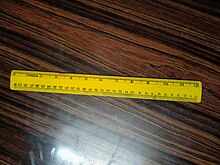
Back Voet (lengtemaat) Afrikaans Piet (unidat) AN قدم (وحدة قياس) Arabic Pie (unidá) AST Kayu takt'a Aymara Fut Azerbaijani Фут Byelorussian Фут BE-X-OLD Фут Bulgarian फुट (इकाई) Bihari
| foot | |
|---|---|
 A foot-long ruler | |
| General information | |
| Unit system | Imperial/US units |
| Unit of | Length |
| Symbol | ft, ′ |
| Conversions | |
| 1 ft in ... | ... is equal to ... |
| Imperial/US units | |
| Metric (SI) units | |
The foot (standard symbol: ft)[1][2] is a unit of length in the British imperial and United States customary systems of measurement. The prime symbol, ′, is commonly used to represent the foot.[3] In both customary and imperial units, one foot comprises 12 inches, and one yard comprises three feet. Since an international agreement in 1959, the foot is defined as equal to exactly 0.3048 meters.
Historically, the "foot" was a part of many local systems of units, including the Greek, Roman, Chinese, French, and English systems. It varied in length from country to country, from city to city, and sometimes from trade to trade. Its length was usually between 250 mm and 335 mm and was generally, but not always, subdivided into 12 inches or 16 digits.
The United States is the only industrialized country that uses the (international) foot in preference to the meter in its commercial, engineering, and standards activities.[4] The foot is legally recognized in the United Kingdom; road distance signs must use imperial units (however, distances on road signs are always marked in miles or yards, not feet; bridge clearances are given in meters as well as feet and inches), while its usage is widespread among the British public as a measurement of height.[5][6] The foot is recognized as an alternative expression of length in Canada.[7] Both the UK and Canada have partially metricated their units of measurement. The measurement of altitude in international aviation (the flight level unit) is one of the few areas where the foot is used outside the English-speaking world.
The most common plural of foot is feet. However, the singular form may be used like a plural when it is preceded by a number, as in "he is six foot tall."[8]
- ^ Cite error: The named reference
IEEEwas invoked but never defined (see the help page). - ^ BS350:Part 1:1974 Conversion factors and tables Part 1. Basis of tables. Conversion factors. British Standards Institution. 1974. pp. 5, 91.
- ^ Chicago Manual of Style (17th ed.). University of Chicago Press. 2017. ¶ 10.66.
- ^ "Appendix G – Weights and Measures". The World Factbook. Washington: Central Intelligence Agency. January 17, 2007. Archived from the original on February 23, 2011. Retrieved February 4, 2007.
- ^ Kelly, Jon (December 21, 2011). "Will British people ever think in metric?". BBC. Archived from the original on April 24, 2012.
- ^ Alder, Ken (2002). The Measure of all Things—The Seven-Year-Odyssey that Transformed the World. London: Abacus.
- ^ Weights and Measures Act Archived December 28, 2014, at the Wayback Machine, accessed January 2012, Act current to January 18, 2012. Basis for units of measurement 4.(1) All units of measurement used in Canada shall be determined on the basis of the International System of Units established by the General Conference of Weights and Measures. (...) Canadian units (5) The Canadian units of measurement are as set out and defined in Schedule II, and the symbols and abbreviations therefore are as added pursuant to subparagraph 6(1)(b)(ii).
- ^ "foot, noun". Oxford English Dictionary. Oxford University Press. Retrieved June 13, 2024.